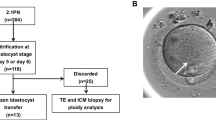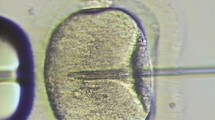Abstract
Purpose
The aim was to investigate the relationship between the presence of the meiotic spindle (MS) and zona pellucida (ZP) birefringence of MII oocytes with morphokinetics variables of derived embryos in ICSI setting.
Methods
Using a polarization imaging system, the ZP birefringence and presence of MS were evaluated pre ICSI. Also, morphokinetics variables including time of second PB extrusion (tPB2), time of pronuclei appearance (tPNa), time of pronuclei fading (tPNf), time of two to eight discrete cells (t2–t8) ECC1 (t2−tPB2), cc2a (t3−t2), S2 (t4−t3) and S3 (t8−t5) as well as irregular cleavage events of 368 embryos were analyzed with time lapse monitoring (TLM).
Results
t5 occurred earlier in high birefringent ZP (HB-ZP) compared with low birefringent oocytes (LB-ZP; p = 0.001). In addition, t2 happened later in invisible MS compared to visible MS oocytes (p = 0.013). There were significantly lower rates of cell fusion (Fu) in oocytes with HB-ZP and also the Fu and trichotomous mitoses (TM) together in visible MS oocytes (p = 0.005, p = 0.001 and p = 0.001, respectively).
Conclusions
Both t2 and t5 timings and irregular cleavage events of embryos were correlated with ZP birefringence and MS status, respectively. So, combining the information from both oocyte polarization microscopy imaging and embryo TLM can be a useful tool for single embryo transfer (SET) program.


Similar content being viewed by others
References
Adamson GD, Abusief ME, Palao L, Witmer J, Palao LM, Gvakharia M (2016) Improved implantation rates of day 3 embryo transfers with the use of an automated time-lapse–enabled test to aid in embryo selection. Fertil Steril 105:369–375
Chen F, De Neubourg D, Debrock S, Peeraer K, D’Hooghe T, Spiessens C (2016) Selecting the embryo with the highest implantation potential using a data mining based prediction model. Reprod Biol Endocrin 14(1):1
Faramarzi A, Khalili MA, Soleimani M (2015) First successful pregnancies following embryo selection using Time-lapse technology in Iran: case report. Iran J Reprod Med 13(4):237
Chamayou S, Patrizio P, Storaci G, Tomaselli V, Alecci C, Ragolia C et al (2013) The use of morphokinetic parameters to select all embryos with full capacity to implant. J Assist Reprod Genet 30(5):703–710
Dar S, Lazer T, Shah PS, Librach CL (2014) Neonatal outcomes among singleton births after blastocyst versus cleavage stage embryo transfer: a systematic review and meta-analysis. Hum Repord Update 0:1–10
Liu Y, Chapple V, Roberts P, Matson P (2014) Prevalence, consequence, and significance of reverse cleavage by human embryos viewed with the use of the Embryoscope time-lapse video system. Fertil steril 102(5):1295–1300.e2
Aparicio-Ruiz B, Basile N, Albalá SP, Bronet F, Remohí J, Meseguer M (2016) Automatic time-lapse instrument is superior to single-point morphology observation for selecting viable embryos: retrospective study in oocyte donation. Fertil Steril 106:1379–1385
Rubio I, Galán A, Larreategui Z, Ayerdi F, Bellver J, Herrero J et al (2014) Clinical validation of embryo culture and selection by morphokinetic analysis: a randomized, controlled trial of the EmbryoScope. Fertil steril 102(5):1287–1294.e5
Madaschi C, de Souza Bonetti TC, Braga DPdAF, Pasqualotto FF, Iaconelli A, Borges E (2008) Spindle imaging: a marker for embryo development and implantation. Fertil Steril 90(1):194–198
Halvaei I, Khalili MA, Razi MH, Nottola SA (2012) The effect of immature oocytes quantity on the rates of oocytes maturity and morphology, fertilization, and embryo development in ICSI cycles. J Assist Reprod Genet 29(8):803–810
Khalili MA, Mojibian M, Sultan A-M (2005) Role of oocyte morphology on fertilization and embryo formation in assisted reproductive techniques. MEFS 10:72–77
Madaschi C, Aoki T, Braga DPdAF, Figueira RdCS, Francisco LS, Iaconelli A et al (2009) Zona pellucida birefringence score and meiotic spindle visualization in relation to embryo development and ICSI outcomes. Reprod Biomed Online 18(5):681–686
Raju GR, Prakash G, Krishna KM, Madan K (2007) Meiotic spindle and zona pellucida characteristics as predictors of embryonic development: a preliminary study using PolScope imaging. Reprod Biomed Online 14(2):166–174
Ashourzadeh S, Khalili MA, Omidi M, Mahani SNN, Kalantar SM, Aflatoonian A et al (2015) Noninvasive assays of in vitro matured human oocytes showed insignificant correlation with fertilization and embryo development. Arch Gynecol Obstet 292(2):459–463
Montag M, Schimming T, Köster M, Zhou C, Dorn C, Rosing B (2008) Oocyte zona birefringence intensity is associated with embryonic implantation potential in ICSI cycles. Reprod Biomed Online 16(2):239–244
Ciray HN, Campbell A, Agerholm IE, Aguilar J, Chamayou S, Esbert M (2014) Proposed guidelines on the nomenclature and annotation of dynamic human embryo monitoring by a time-lapse user group. Hum Repord 29(12):2650–2660
Wirka KA, Chen AA, Conaghan J, Ivani K, Gvakharia M, Behr B et al (2014) Atypical embryo phenotypes identified by time-lapse microscopy: high prevalence and association with embryo development. Fertil Steril 101(6):1637–1648.e5
Kirkegaard K, Ahlström A, Ingerslev HJ, Hardarson T (2015) Choosing the best embryo by time lapse versus standard morphology. Fertil Steril 103(2):323–332
Świątecka J, Anchim T, Leśniewska M, Wołczyński S, Bielawski T, Milewski R (2014) Oocyte zona pellucida and meiotic spindle birefringence as a biomarker of pregnancy rate outcome in IVF-ICSI treatment. Ginekol polska 1(85):264–271
Keefe D, Kumar M, Kalmbach K (2015) Oocyte competency is the key to embryo potential. Fertil Steril 103(2):317–322
Petersen C, Oliveira J, Mauri A, Massaro F, Baruffi R, Pontes A et al (2009) Relationship between visualization of meiotic spindle in human oocytes and ICSI outcomes: a meta-analysis. Reprod Biomed Online 18(2):235–243
Kilani S, Cooke S, Tilia L, Chapman M (2011) Does meiotic spindle normality predict improved blastocyst development, implantation and live birth rates? Fertil Steril 96(2):389–393
Ebner T, Balaban B, Moser M, Shebl O, Urman B, Ata B et al (2010) Automatic user-independent zona pellucida imaging at the oocyte stage allows for the prediction of preimplantation development. Fertil Steril 94(3):913–920
Matsunaga R, Watanabe S, Miura M, Kobayashi Y, Yamanaka N, Kamihata M et al (2016) A new approach to evaluate the influence of advancing maternal age upon meiotic spindle morphology and developmental competence in human oocytes. Fertil Steril 106(3):e350–e351
Dib LA, Da Broi MG, Navarro PA (2014) Comparative analysis of the spindle of fresh in vivo-matured human oocytes through polarized light and confocal microscopy a pilot study. Reprod Sci 21(8):984–992
Magli MC, Capoti A, Resta S, Stanghellini I, Ferraretti AP, Gianaroli L (2011) Prolonged absence of meiotic spindles by birefringence imaging negatively affects normal fertilization and embryo development. Reprod Biomed Online 23(6):747–754
Kilani S, Cooke S, Kan A, Chapman M (2009) Are there non-invasive markers in human oocytes that can predict pregnancy outcome? Reprod Biomed Online 18(5):674–680
Gu Y-F, Lu C-F, Lin G, Lu G-X (2010) A comparative analysis of the zona pellucida birefringence of fresh and frozen–thawed human embryos. Reprod 139(1):121–127
Liu Y, Chapple V, Feenan K, Roberts P, Matson P (2015) Clinical significance of intercellular contact at the four-cell stage of human embryos, and the use of abnormal cleavage patterns to identify embryos with low implantation potential: a time-lapse study. Fertil Steril 103(6):1485–1491.e1
Lemmen J, Agerholm I, Ziebe S (2008) Kinetic markers of human embryo quality using time-lapse recordings of IVF/ICSI-fertilized oocytes. Reprod Biomed Online 17(3):385–391
Meseguer M, Herrero J, Tejera A, Hilligsøe KM, Ramsing NB, Remohí J (2011) The use of morphokinetics as a predictor of embryo implantation. Hum Reprod 26(10):2658–2671
Cruz M, Garrido N, Herrero J, Pérez-Cano I, Muñoz M, Meseguer M (2012) Timing of cell division in human cleavage-stage embryos is linked with blastocyst formation and quality. Reprod Biomed Online 25(4):371–381
Gardner DK, Weissman A, Howles CM, Shoham Z (2012) Textbook of assisted reproductive techniques fourth edition: volume 2: Clinical perspectives: CRC press
Desai N, Ploskonka S, Goodman LR, Austin C, Goldberg J, Falcone T (2014) Analysis of embryo morphokinetics, multinucleation and cleavage anomalies using continuous time-lapse monitoring in blastocyst transfer cycles. Reprod Biol Endocrin 12(1):54
Rubio I, Kuhlmann R, Agerholm I, Kirk J, Herrero J, Escribá M-J et al (2012) Limited implantation success of direct-cleaved human zygotes: a time-lapse study. Fertil Steril 98(6):1458–1463
Almagor M, Or Y, Fieldust S, Shoham Z (2015) Irregular cleavage of early preimplantation human embryos: characteristics of patients and pregnancy outcomes. J Assist Reprod Genet 32(12):1811–1815
Author information
Authors and Affiliations
Corresponding author
Ethics declarations
Funding
This study was funded by Yazd research and clinical center for infertility.
Conflict of interest
All authors declare no conflict of interest.
Ethical approval
The present study conforms to the provisions of the Declaration of Helsinki. Also, this study was approved by the Institutional Review Board of the Yazd Research and Clinical Center for Infertility (IR.SSU.MEDICINE.REC.1395.2). The unique nature of identifying patients was completely preserved.
Informed consent
Informed consent was obtained from all participants included in the study.
Authors’ contribution
Azita Faramarzi: data collection, methodology, writing; Azam Agh-Rahimi: writing, data analysis; Marjan Omidi: language editing, data analysis; Mohammad Ali Khalili: leader of study, methodology, editing the paper.
Rights and permissions
About this article
Cite this article
Faramarzi, A., Khalili, M.A., Agha-Rahimi, A. et al. Is there any correlation between oocyte polarization microscopy findings with embryo time lapse monitoring in ICSI program?. Arch Gynecol Obstet 295, 1515–1522 (2017). https://doi.org/10.1007/s00404-017-4387-8
Received:
Accepted:
Published:
Issue Date:
DOI: https://doi.org/10.1007/s00404-017-4387-8




